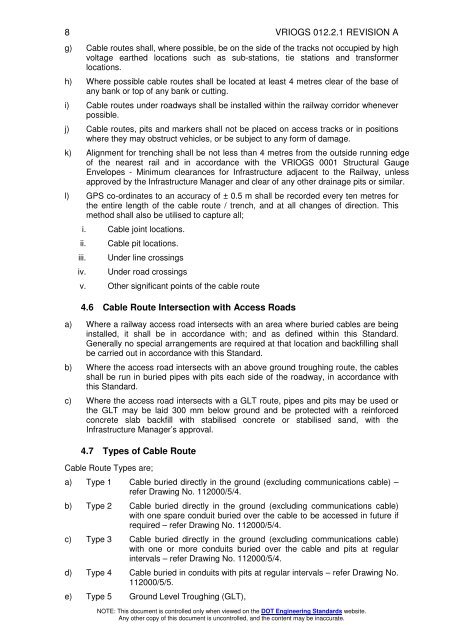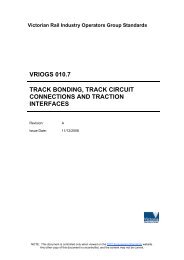VRIOGS 012.2.1 - Public Transport Victoria
VRIOGS 012.2.1 - Public Transport Victoria
VRIOGS 012.2.1 - Public Transport Victoria
You also want an ePaper? Increase the reach of your titles
YUMPU automatically turns print PDFs into web optimized ePapers that Google loves.
8 <strong>VRIOGS</strong> <strong>012.2.1</strong> REVISION A<br />
g) Cable routes shall, where possible, be on the side of the tracks not occupied by high<br />
voltage earthed locations such as sub-stations, tie stations and transformer<br />
locations.<br />
h) Where possible cable routes shall be located at least 4 metres clear of the base of<br />
any bank or top of any bank or cutting.<br />
i) Cable routes under roadways shall be installed within the railway corridor whenever<br />
possible.<br />
j) Cable routes, pits and markers shall not be placed on access tracks or in positions<br />
where they may obstruct vehicles, or be subject to any form of damage.<br />
k) Alignment for trenching shall be not less than 4 metres from the outside running edge<br />
of the nearest rail and in accordance with the <strong>VRIOGS</strong> 0001 Structural Gauge<br />
Envelopes - Minimum clearances for Infrastructure adjacent to the Railway, unless<br />
approved by the Infrastructure Manager and clear of any other drainage pits or similar.<br />
l) GPS co-ordinates to an accuracy of ± 0.5 m shall be recorded every ten metres for<br />
the entire length of the cable route / trench, and at all changes of direction. This<br />
method shall also be utilised to capture all;<br />
i. Cable joint locations.<br />
ii.<br />
iii.<br />
iv.<br />
Cable pit locations.<br />
Under line crossings<br />
Under road crossings<br />
v. Other significant points of the cable route<br />
4.6 Cable Route Intersection with Access Roads<br />
a) Where a railway access road intersects with an area where buried cables are being<br />
installed, it shall be in accordance with; and as defined within this Standard.<br />
Generally no special arrangements are required at that location and backfilling shall<br />
be carried out in accordance with this Standard.<br />
b) Where the access road intersects with an above ground troughing route, the cables<br />
shall be run in buried pipes with pits each side of the roadway, in accordance with<br />
this Standard.<br />
c) Where the access road intersects with a GLT route, pipes and pits may be used or<br />
the GLT may be laid 300 mm below ground and be protected with a reinforced<br />
concrete slab backfill with stabilised concrete or stabilised sand, with the<br />
Infrastructure Manager’s approval.<br />
4.7 Types of Cable Route<br />
Cable Route Types are;<br />
a) Type 1 Cable buried directly in the ground (excluding communications cable) –<br />
refer Drawing No. 112000/5/4.<br />
b) Type 2 Cable buried directly in the ground (excluding communications cable)<br />
with one spare conduit buried over the cable to be accessed in future if<br />
required – refer Drawing No. 112000/5/4.<br />
c) Type 3 Cable buried directly in the ground (excluding communications cable)<br />
with one or more conduits buried over the cable and pits at regular<br />
intervals – refer Drawing No. 112000/5/4.<br />
d) Type 4 Cable buried in conduits with pits at regular intervals – refer Drawing No.<br />
112000/5/5.<br />
e) Type 5 Ground Level Troughing (GLT),<br />
NOTE: This document is controlled only when viewed on the DOT Engineering Standards website.<br />
Any other copy of this document is uncontrolled, and the content may be inaccurate.

















